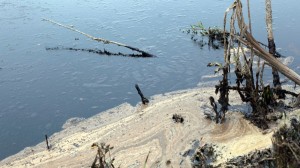Major Oil Spills In Alberta Prompt Questions And Concerns About Keystone XL Pipeline
 The proposed Keystone XL pipeline running from Alberta’s tar sands south to Nebraska and Texas continues to stay in the public eye. Mitt Romney gave it center stage in a campaign ad released today, and the House Republicans attempted to attach it to a drilling bill that passed yesterday.
The proposed Keystone XL pipeline running from Alberta’s tar sands south to Nebraska and Texas continues to stay in the public eye. Mitt Romney gave it center stage in a campaign ad released today, and the House Republicans attempted to attach it to a drilling bill that passed yesterday.But this week it was reported that over the past few months, a million liters (quarter million gallons) of oil from several pipelines have spilled in Alberta. Canada’s The Star reported on Wednesday that cleanup crews are working to prevent contamination from the three major oil spills:
The latest spill occurred earlier this week in northeastern Alberta near the town of Elk Point, where Enbridge confirmed a spill of about 230,000 liters through its pumping station on the Athabasca pipeline. The biggest incident was earlier this month near Red Deer and Sundre in central Alberta, where 475,000 liters of oil from Plains Midstream Canada leaked, some of it spilling into the Red Deer River.
This is not the first time the Canadian tar sands giant, Enbridge, has been involved with an oil spill. In July 2010 one of its pipelines ruptured in Marshall, Michigan and spilled an estimated 819,000 gallons.
Even proponents of the Keystone XL pipeline see these incidences as worrisome, and confidence in the tar sands extraction and transportation throughout Canada has clearly been shaken. For example, Doug Bloom of the Canadian Energy Pipeline Association and president of Spectra Energy said:
Any spill right now is going to be bad timing. There’s such a focus now with Gateway and with Keystone XL and other projects going through regulatory review. Any time there’s any kind of an incident no matter how large or how small, it’s going to be prominent.
The 1,700 mile long Keystone XL pipeline proposed by TransCanada would run from Alberta down to Houston, Texas and move 435,000 barrels of heavy crude oil per day. Environmentalists and residents near the proposed pipeline fear that that it could leak in critical areas such as Nebraska’s Ogallala Aquifer.
TransCanada’s own analysis shows that the Keystone XL pipeline would have 11 “significant spills” over its 50-year lifecycle, while an independent study estimated that there could be as many as 91 spills. The first leg of the Keystone pipeline even suffered 12 spills in 2010 – a record for a pipeline’s first year in operation.
Although not always reported in the media, oil spills from pipelines, wells, and infrastructure happen so frequently that at this point they are just part of doing business for oil companies. For example, a report from USA Today found an average of 22 large spills offshore every year between 2005 and 2009.
And yet, the spill has not deterred proponents of the pipeline. In fact, Canadian Premier Alison Redford has called for an investigation into the spills, while still trying to get Keystone XL built over the Canadian-American border.
You can return to the main Market News page, or press the Back button on your browser.

